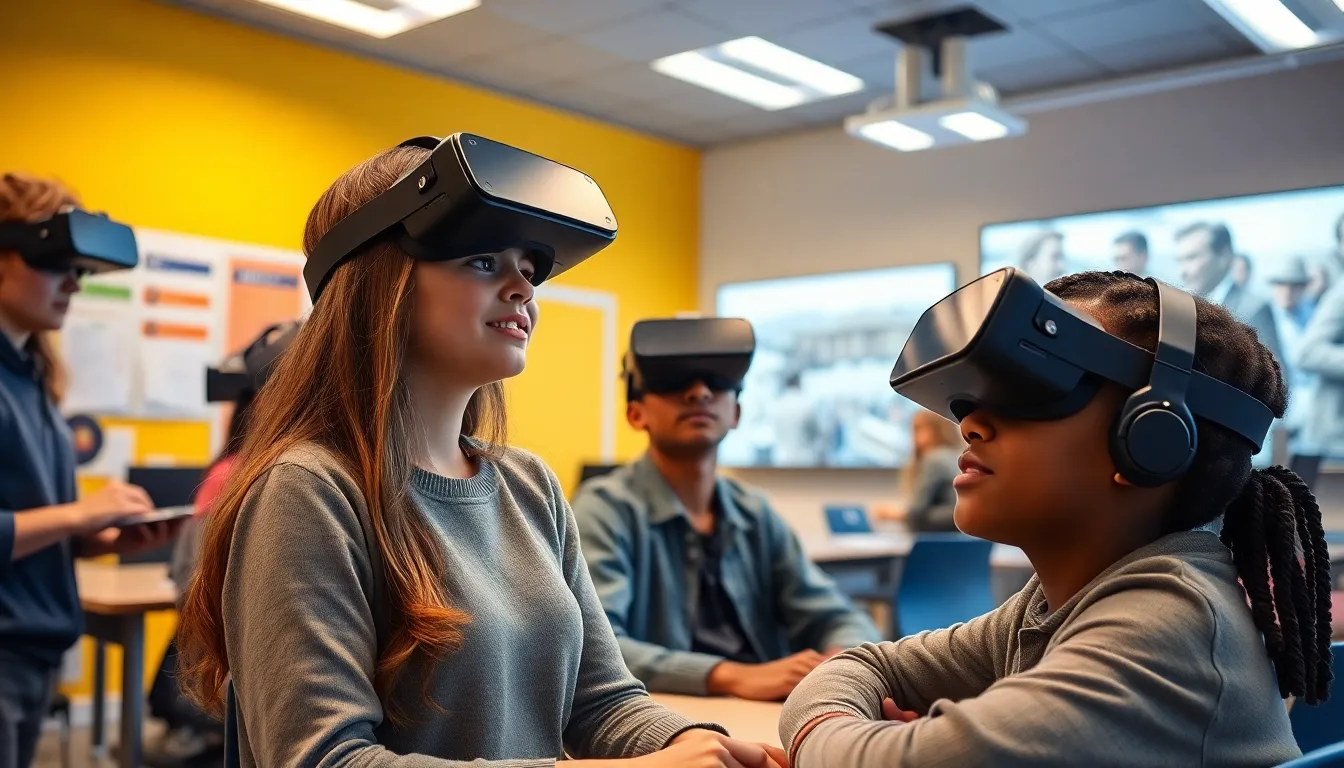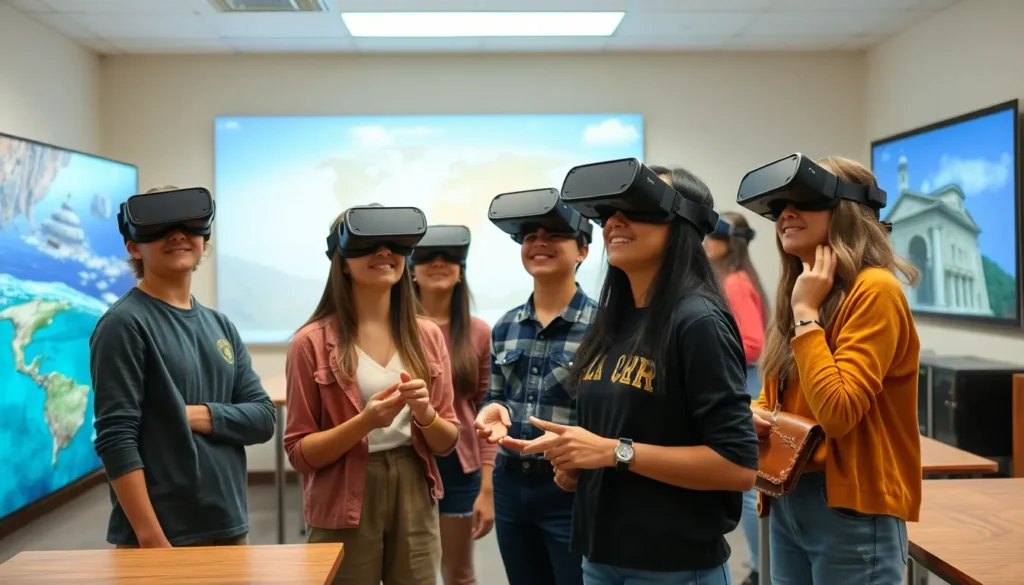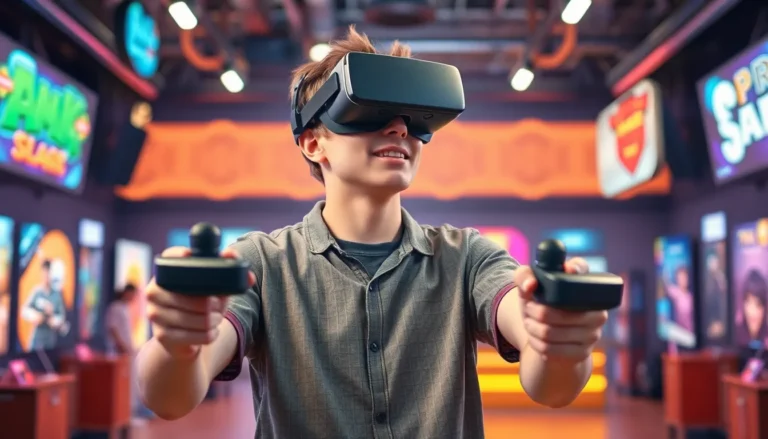Table of Contents
ToggleImagine stepping into a classroom where textbooks are replaced by immersive worlds and lessons come alive in 3D. Welcome to the future of learning: virtual reality education. It’s not just a techy gimmick; it’s a game changer that promises to transform how students engage with knowledge.
Gone are the days of boring lectures and endless note-taking. With VR, students can dive into the depths of the ocean, stroll through ancient civilizations, or even explore the far reaches of outer space—all from the comfort of their classroom. This isn’t just about fun and games; it’s about creating memorable experiences that enhance understanding and retention.
Overview Of VR Education
Virtual reality education utilizes immersive technology to transform the learning landscape. Students interact with three-dimensional virtual environments, which fosters deeper engagement. Science classes can simulate experiments inside active volcanoes while history lessons transport learners to ancient Rome.
VR tools enhance situational learning by providing realistic scenarios. For example, medical students can practice procedures in virtual operating rooms, gaining experience without real-life consequences. Similarly, language learners can converse with avatars in culturally relevant settings, building confidence in speaking skills.
Educators find VR effective in catering to diverse learning styles. Visual and kinesthetic learners may thrive in environments where they can see and manipulate objects. Auditory learners benefit from interactive lessons featuring dynamic audio elements within the VR settings.
Cost remains a key consideration for institutions adopting VR technology. Initial investments in equipment and software can be high, yet many schools seek partnerships with tech companies to offset expenses. Grants and funding opportunities also provide financial support for integrating VR.
Research highlights VR’s potential in improving knowledge retention. Studies show that students exposed to immersive content may retain information up to four times better than those using traditional methods. These statistics emphasize VR’s effectiveness in making learning both enjoyable and impactful.
Adoption of VR education continues to expand across various levels of academia. Universities, high schools, and even elementary schools are pioneering these experiences to enhance curricula. As technology evolves, the possibilities for VR in education will increase, creating innovative avenues for learning.
Benefits Of VR Education

Virtual reality education offers numerous advantages, significantly transforming how students learn. These benefits include enhanced engagement and improved retention, both crucial for effective learning experiences.
Enhanced Engagement
Immersive environments inherently captivate students’ attention. Experiencing historical events or exploring distant planets engages multiple senses, making learning more vibrant. Activities in VR encourage participatory learning, allowing students to manipulate 3D objects and solve problems in real time. Educators witness increased participation when students interact with realistic simulations, whether conducting chemistry experiments or navigating complex ecosystems. This hands-on experience promotes curiosity, driving students to explore and ask questions. As they actively immerse themselves in these scenarios, motivation to learn also rises.
Improved Retention
Retention of information often sees significant improvement with VR. Studies demonstrate that immersive experiences can enhance knowledge retention rates by up to four times compared to traditional learning methods. Engaging multiple senses may lead to deeper connections to the material, creating lasting memories. Learners find it easier to recall facts and concepts encountered in virtual settings after their experiences. Real-world applications, like medical procedures practiced in VR environments, help solidify understanding and memory. This immersive approach equips students with the confidence to apply their knowledge effectively in real-life situations.
Challenges In VR Education
While VR education offers unique advantages, several challenges exist that institutions must address.
High Costs
Adopting VR technology incurs significant expenses. Schools face high initial investments for equipment and software. The average cost for a VR headset ranges from $300 to $1,000 per unit, depending on the features. Additional costs include content development and training for educators, which can further strain budgets. Many institutions rely on partnerships or grants to mitigate these financial burdens. Research indicates that while expenses are high, the potential for improved knowledge retention and engagement can justify the investment. Schools must evaluate long-term benefits against short-term costs in order to establish a sustainable VR learning environment.
Technical Limitations
Technical hurdles hinder the seamless integration of VR in education. Hardware limitations often impact performance and usability. Many VR systems require powerful computers, which may not be available in all classrooms. Network connectivity issues can disrupt immersive experiences, leading to frustration among students. Additionally, software compatibility varies across different VR platforms, causing difficulties in maintaining consistent educational content. These technical barriers can impede the widespread adoption of VR. Educators and institutions must continue to collaborate with tech developers to address these challenges head-on.
Case Studies In VR Education
Virtual reality education showcases transformative practices through various case studies. These examples highlight successful implementations of VR technology in learning environments.
Success Stories
Pioneering institutions such as Stanford University utilize VR to enhance medical training. In this context, medical students participate in simulated surgeries that replicate real-life scenarios. Similarly, the University of Illinois integrates VR into history classes, allowing students to explore ancient Egypt, thereby enriching their understanding of cultural heritage. Additionally, schools in California employ VR to teach science, giving learners the opportunity to dive into oceans and study marine life firsthand. Such innovative applications of VR not only engage students, but also significantly improve knowledge retention.
Lessons Learned
Implementing VR in education reveals critical insights for educators and institutions. First, training educators to effectively use VR tools remains essential. Without proper guidance, students may not fully benefit from the immersive experiences. Furthermore, ensuring access to reliable technology minimizes disruptions during lessons, as connectivity issues can impede learning. Collaboration between educators and VR developers fosters strong content creation tailored to curriculum needs. Additionally, incorporating student feedback provides valuable insights into enhancing VR resources. These lessons help institutions refine their approaches to implementing VR, ensuring a more impactful educational experience.
Future Trends In VR Education
Emerging trends in VR education reflect advancements in technology and pedagogical strategies. Increased accessibility to VR tools drives more schools to integrate these technologies into their curricula. Schools increasingly adopt cloud-based platforms for delivering VR content, reducing costs and enhancing collaboration between educators and developers.
Immersive learning experiences evolve to include social interactions among students in virtual spaces. Platforms facilitating peer-to-peer learning allow students to engage in group projects set in virtual environments. These collaborative activities strengthen communication skills and foster teamwork.
Artificial intelligence plays a critical role in personalizing VR learning experiences. Customized content adapts to individual learning paces and styles, ensuring engagement remains high throughout the learning process. Engagement metrics suggest that tailored experiences enhance retention rates significantly.
Research supports the integration of gamification elements within VR environments. Introducing rewards and challenges encourages motivation among students. Alongside this, real-time feedback during simulations ensures users grasp concepts effectively, leading to higher retention levels.
Developers increasingly focus on creating realistic simulations across various disciplines. Advanced graphics and interactive elements make experiences more relatable. For instance, medical training programs simulate complex surgical procedures, while history lessons transport students to pivotal moments in time.
Emerging partnerships with tech companies will likely enhance the scope of VR applications in education. Collaborations may lead to developing innovative tools that enrich learning experiences. Thus, the future of VR education appears promising, with potential for widespread adoption across diverse educational settings.
The future of VR education holds immense promise for transforming how students learn. With its ability to create immersive experiences and cater to various learning styles, VR is set to redefine educational engagement. While challenges like cost and technology access remain, ongoing collaboration between educators and tech developers can pave the way for innovative solutions.
As VR technology continues to evolve, its integration into curricula will likely expand, offering dynamic learning opportunities that enhance knowledge retention. The incorporation of artificial intelligence and gamification will further enrich these experiences, making learning more interactive and personalized. Embracing VR in education not only prepares students for the future but also fosters a deeper understanding of complex subjects through hands-on exploration.




